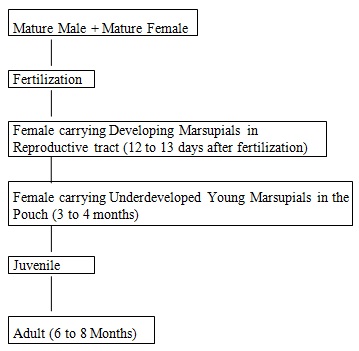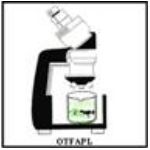Topics Covered in this Section
18.2 How is this Unit Organized?
18.3 Some background about the Opossum (Didelphis marsupialis insularis) Production
18.4 An approach at developing an Intensive Animal Production System for the Opossum
[I] The Objectives of the Production System or Model
III] The Physiological States for the Production Flow
[IV] Performance Coefficients or Growth Parameters
[VI] Animal Specific Needs as influenced by the Factors affecting animal Production Needs
[VII] Animal Behavior and Sociology
[VIII] Design of the Physical Environment Required
[IX] Management Routines Required
[XI] Output Expectations of the Model/Production Process Flow
AGLS 6502 Lecture 18 - Intensification of Opossum (Manicou) Production
1. to be able to describe the animal production factors affecting the Opossum ( Didelphis marsupialis insularis );
2. to understand the animal production coefficients and parameters for the Opossum ( Didelphis marsupialis insularis ); and to see how this would relate to production of this species in captivity;
3.to become familiar with an approach to the intensification of the Opossum ( Didelphis marsupialis insularis ) production.
back to top
18.2 How is this Unit Organized?
In this section / unit we would first attempt to give you some background on the opossum and then proceed to develop the information needed for outlining the production system.
18.3 Some background about the Opossum (Didelphis marsupialis insularis) Production
Didelphis genus |
(Large American Opossum) has three (3) species. |
Didelphis albiventris |
(Columbia and Venezuela to Central Argentina) |
Didelphis virginiana |
[Virginia Opossum] [New Hampshire to Colorado , Southern Ontario to Costa Rica] |
Didelphis marsupialis |
[Eastern Mexico to Northern Argentina] |
Didelphis aurita |
of eastern Brazil is another suggested species. |
Didelphis marsupialis is restricted to the humid broard-leaved forests. This genus is largely nocturnal, and they construct rough nests of leaves and grasses under piles of dead bush or in burrows.
The opossum is an animal which has a very wide dietary intake and is very antisocial. it is not a communal animal. However if animals are taken care of from very young they could become somewhat gentle and can be handled easily. There is a community unit in Miami which takes care of orphaned opossums. The staff at the Miami Zoo (Children’s Zoo ) are very capable at handling opossums.
Although animals can be weaned at four months of age (120 days ), litter mates could continue to live in the same nest provided there is adequate food and space. However their mother must be removed as the animals at this point could shift from suckling their mother to cannibalizing her.
Jurgelski (1974) has suggested that the animal could be managed intensively similarly to the systems used for rabbits.
18.4 An approach at developing an Intensive Animal Production System
Considerations For Species Production Modeling
The Species : The Opossum ( Didelphis marsupialis insularis )
[I] The Objectives of the Production System or Model
1. To have a productive opossum breeding colony in captivity.
2. To grow out the animals born in captivity to an economically marketable weight.
3. To grow out colony replacement breeders.
4. To grow out some animals for release into the wild.

[III] The Physiological States for the Production Flow
- Mature Breeding Male
- Mature Breeding Female
- Female carrying Developing Marsupials in the Reproductive tract ( 12 to 13 days after fertilization)
- Female carrying Underdeveloped Young Marsupials in the Pouch ( 3 to 4 months )
- Suckling young
- Juvenile
- Mature male replacements
- Mature female replacements
[IV] Performance Coefficients or Growth Parameters
| Characteristics | Parameter |
Body Length |
32.5 to 50 cms |
Tail Length |
25.5 to 53.5 cms |
Mature Body Weight |
2 to 5.5 kg |
Male |
2 to 5.5 kg |
Female |
2 to 5.5 kg |
Birth weight |
0.13 g |
Growth Rate |
- in the wild g/day - in captivity g/ month |
Market Weight |
|
Carcass Dressing % (DP) |
|
back to top
[V] Reproductive Parameters
| Characteristics | Parameter |
Gestation Length |
12 to 13 days |
Offspring / litter ( Average) |
1 to 13 |
Length of estrous cycle
|
17-38 days ( Ave 25.5 ) |
Length of estrus |
12 hours ( but are receptive for 1 |
Next estrus after parturition |
after weaning or removal of the |
Time for rebreeding |
2 to 8 days after weaning |
Time of Ovulation |
Ovulation in the opossum is independent of coitial stimulation and does bear a precise or consistent time relationship to estrus ( receptivity of the male ). It occurs a few hours before or after copulation. But fertilization takes place within 24 hours after copulation. |
Puberty |
5 months ?? 6 months |
Sex Ratio |
|
Lactation Period |
12-16 weeks |
Weaning Age |
12-16 weeks |
Number of Kits weaned/ litter |
6 to 8 |
Parturitions / Year |
2 to 3 litters / year |
Breeding Season |
All year depending on conditions |
Age at First Breeding |
6 to 8 months |
Age at first litter |
6.5 to 8.5 months |
Kitting Interval |
About 5 months( assuming weaning at 4 months ) In the wild about 110 days separating winter and spring litter. |
Longevity of Breeding Females |
2 years |
Longevity of Breeding Males |
? |
[VI] Animal Specific Needs as influenced by the Factors Affecting Animal Production Needs
- all hutches or cages must have several dark areas as these animals are nocturnal ; lighting should be subdued ;
- cages should be high with perches and areas to climb as these animals would need some form of activity sites.
- Individual Hutches ( Breeding Males )
- Individual Hutches with nest Boxes ( Breeding Females)
- Growout hutches for keeping nest mates ( could be kept together for about 4 to 6 weeks post weaning ]
- Restraining Crate Design in Jurgelski (1974)
b. Nutrition and Feeding
Very variable diet, which includes small veterbrate, invertebrates and many kinds of vegetable mater.
Diet :
- 3 LB beef liver
- 10 LB Cat Chow [50 % CP, 32 % C Fat, 4% CF, 1.6 to 3.3 % Ca, 1.4 % P - Dry Matter Basis]
- 9 LB water ( 2 gallons )
Blend and serve as follows:
- 180 g / head / day from weaning to adult
- 270 to 360 g/h/day for lactating and pregnant females.
Note: animals fed ad libitum would become obese.
back to top
c. Health and Disease Control
- very disease tolerant animal
- has good injury and repair features
- South American Didelphis sp are susceptible to Yellow Fever Virus.
back to top
d.
Reproductive Management
- Insemination and a resulting pregnancy do not interrupt the estrus cycle of marsupials.
- Pregnancy does not inhibit the continuation of estrus BUT lactation does., the ovarian inhibitor being mediated by the suckling stimulus.
- Weaning would therefore induce the onset of the next estrus cycle.
- A well fed suckling female and a 3 month weaning age should be desired to achieve 3 litters per year.
- mating generally occurs between midnight and 6 am
[VII] Animal Behavior and Sociology
- A nocturnal animal spending the day in rocky crevices, in hollow tree trunks, hollow poles or in dead bush or burrows.
- Terrestrial animals who move with a slow gait.
- Good swimmers.
- Good climbers.
- Basically a solitary and antisocial animal.
- Extreme antagonistic behavior is exhibited if two males meet.
- When a male and a female meet initial aggressive displays turn to courtship and the two animals may spend several days together.
- If a male is placed with a female that is not in estrus she becomes aggressive and the male does not return her attack.
[VIII] Design of the Physical Environment Required
back to top
[IX] Management Routines Required
- Daily
- Weekly
- Monthly
- Seasonally
- Annually
[XI] Output Expectations of the Model/Production Process Flow
| Characteristic | Expectation |
Number of Breeding Females: |
10 |
Number of Breeding Males: |
2 |
Average Weaned Litter size: |
6 |
Litters/ Year/ Female: |
3 |
Total Weaned / Year/ Female: |
18 |
% Retained/ year as replacements |
10% |
Number sold/ year/ female |
16.2 |
Total Salable / Year |
180 - 16.2 = 163.8 |
Atramentowicz, M. (1995): Growth of pouch young in the Bare Tailed wooly opossum, Caluromys philander . Journal of Mammology 76: 1213-1219
Dawson, T. J. (1983): Monotremes and Marsupials . The Other mammals Studies in Biology No 150 Camelot Press, Great Britain
Fleming, T. H. (1973): The reproductive cycle of three species of opossums and other mammals in the Panama Canal Zone. Journal of Mammology 54: 439-455
Gardner, A. L. (1983): Virginia Opossum (Didelphis virginiana). Chapter 1 In : Wild Mammals of North America. Chapman, J.A. and Feldhamer, G. A. (Editors), Second printing, John Hopkins University Press, Maryland, USA. 3-36
Hartman, C. G. (1952): Possums University of Texas Press, Austin Texas.
Hawarth, V. S. (1950 ): Experimental Prostatecomy in a marsupial ( Trichasurus vulpecula ) Med J. Aust 2: 325-330
Jolly, S. E, and Spurr, E. B. (1996 ): Effect of ovariectomy on the social status of bushtail opossums ( Trichosurus vulpecula ) in captivity New Zealand Journal of Zoology 23: 27-32
Jurgelski, W. Jr . (1974): The opossum ( Didelphis virginiana Kerr. ) as a biomedical model: I Research perspective , husbandry and laboratory techniques Laboratory Animal Science 24: 376-403
Jurgelski, W. Jr ., Forsythe, W., Dahl, D., Thomas , L. D. , Moore, J. A., Kotin , P., Falk, H. L., and Vogel, S. (1974): The opossum ( Didelphis virginiana Kerr. ) as a biomedical model: II Breeding the Opossum in Captivity: Facility Design Laboratory Animal Science 24: 404-411
Jurgelski, W. Jr . and Porter, Mary Ellen (1974): The opossum ( Didelphis virginiana Kerr. ) as a biomedical model: III Breeding of the Opossum in Captivity: Methods Laboratory Animal Science 24: 412-425
Mc Manus, J. J. (1970): Behavior of captive opossum Didelphis marsupialis cv Virgianiana American Midl. Nat. 84: 144.69
Mc Manus, J. J. (1974): Didelphis virginiana Mammalian Species no. 40 6pp
Nowak, R. M. (1999) : Walkers Mammals of the World Vol 1: 6th Edition, The John Hopkins University Press, Baltimore, USA, pp 31-33
Renfree, M.B. and Tyndale-Biscoe, C. H. (1978 ) : Manipulation of marsupials embryos and pouch young. In Methods in Mammalian Reproduction Academic Press , New York, Editor J. C. Daniel. 307-331
Reynolds, H. C. (1945) : Some aspects of the life history and ecology of the opossum in Central Missouri. Journal of Mammology 26: 361-379
Rodger, J. C. and Bedford, J. M. (1982a) Induction of oestrus, recovery of gametes, and the timing of fertilization events in the opossum Didelphis virginiana J. Reprod. Fert. 64: 159-169
Rodger, J. C. and Bedford, J. M. (1982b) : Separation of sperm pairs and sperm egg interaction in the opossum, Didelphis virginiana J. Reprod. Fert 64: 171-179
Stodaut, E (1966) : Management and behavior of breeding groups of the Marsupial, Perameles nasuta Geoffrey, in captivity Australian Journal of Zoology 14: 611-623
Tyndale-Biscoe, H. (1973) : Life of Marsupials Elsevier Publishing , NY. USA
Wiseman, G.L. and Hendrickson, G. O. (1950) : Notes on the life history and ecology of the opossum in Southeast Iowa. Journal of Mammology 31: 331-359
Helpful Links, Photos, Videos and Multimedia
